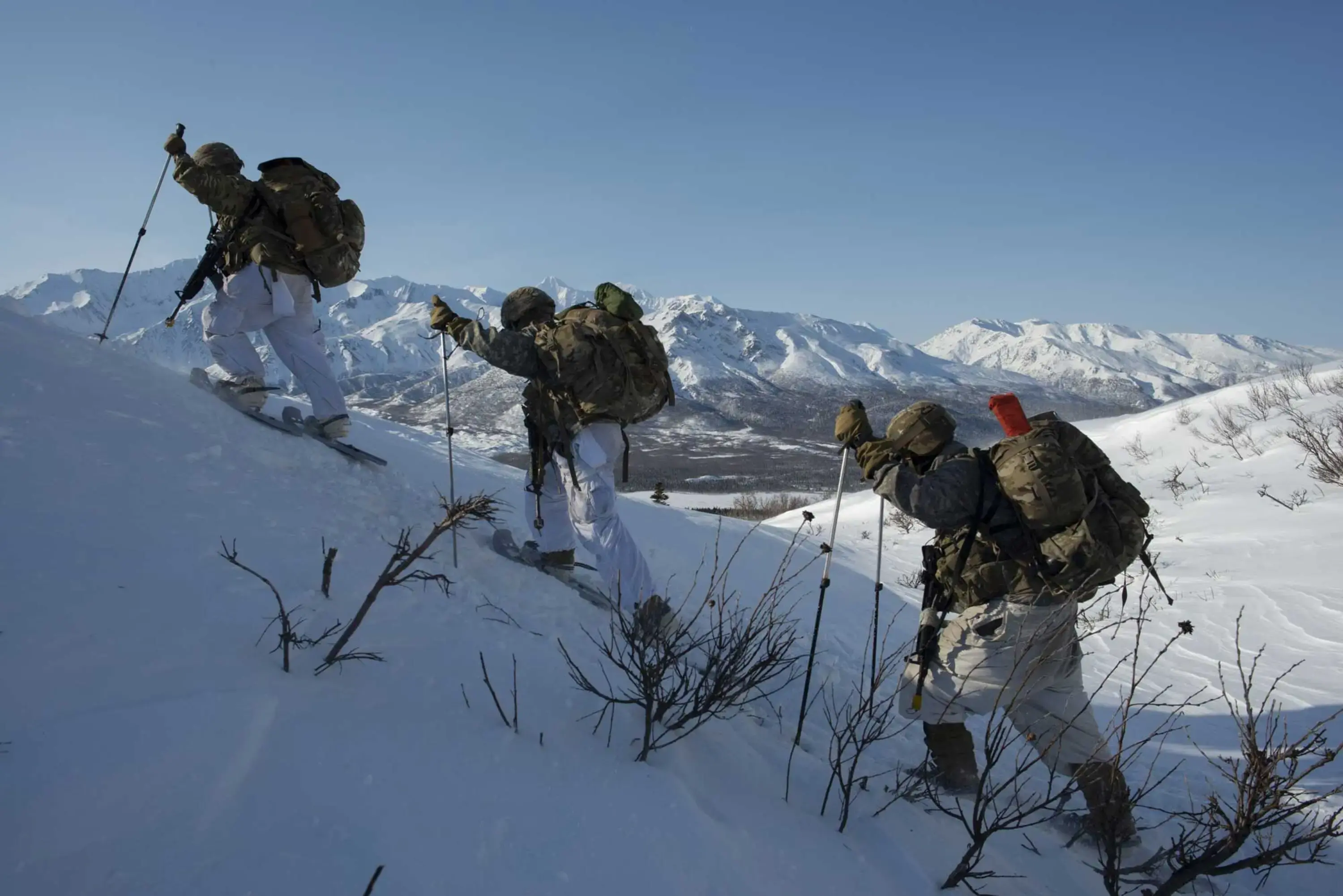
This is the first in a series of articles looking at how climate change and geopolitics are reshaping the High North’s strategic landscape, from the military balance of power to the quest for oil and gas and mineral resources. Watch the video feature here.
“The human eye is designed to pick up on human shapes. You break the shape and they won’t see s**t.”
Sergeant Chavis Dowdy with the 11th Airborne Division of the US Army kicks off camouflage instruction for a handful of soldiers in a copse of birch up a snow-covered mountainside. Here at the Army’s Northern Warfare Training Center in Black Rapids, Alaska, about 180 miles (290 kilometers) south of the Arctic Circle, they’re learning the half-forgotten arts of tomorrow’s potential war at the top of the world.
It’s an unusually mild afternoon in early March, which means that the mercury has crept slightly above freezing. As three troops slowly pull on all-white outfits designed for the treeless tundra of the High North, Dowdy asks: “What about paint?” It’s a trick question. Elsewhere, camo might mean smudging your face. “In the Arctic, you don’t use any kind of paint,” Dowdy tells them.

As a nonprofit journalism organization, we depend on your support to fund more than 170 reporting projects every year on critical global and local issues. Donate any amount today to become a Pulitzer Center Champion and receive exclusive benefits!
“Which brings me to fingernail polish.”
A soldier donning a suit, one of a small number of women on this Cold Weather Leaders Course, asks why, and Dowdy mimics pinching his fingertip through his glove. Chilled to 14F (-10C), the steel trigger on an automatic rifle will drop the skin temperature of your finger to a freezing 32F in 15 seconds. At -13F, it takes less than a second. One test for frostbite involves squeezing the nail and seeing how quickly the blood rushes back in when you let go (if it takes several seconds: not good). That’s hard to check if you’re wearing lacquer.
Once suited up, the three ghostly soldiers head off and the rest of the squad are tasked with spotting them. After going only 25 yards, they seem to have vanished.

America’s State of Anxiety
Alaska has been winking in and out of the American consciousness since its purchase from Russia in 1867. Besides gold, lumber, fish and, of course, oil, the territory has provided an abundance of anxiety. Statehood in 1959 owed much to the shock of Japan’s occupation of several of the Aleutian Islands during World War II, the first of continental US territory since the War of 1812, and to the tripwire tensions of the subsequent Cold War. Less than three miles away from Russian territory at its closest point, Alaska was a frontline state until the collapse of the Soviet Union, hosting radar stations, strategic bombers and naval bases.
Now, as geopolitical tension encroaches on the Arctic, the US is once again experiencing a Sputnik moment in its far north. More effective and relentless than any artillery, climate change is crumbling the Arctic’s walls of ice, raising hopes of access to its resources and new sea routes to project power and influence. A 2008 report from the US Geological Survey teased the “largest unexplored prospective area for petroleum remaining on Earth.” Old World riches like gold and the building blocks of new technologies like rare earth metals and graphite are also scattered around up there.
Russia is campaigning to carve out a large zone of economic exclusivity in the Arctic and has invested heavily in rebuilding its military capabilities there, fueling angst that the US is being left behind (after the missile gap comes the icebreaker gap). Meanwhile, China has artfully declared itself a “near Arctic nation,” underlining its intention to muscle into the region as a “polar great power” and establish a presence in an echo of the South China Sea.

As a result, Washington’s gaze has been drawn northward with an intensity not seen in decades. In 2019, then-Secretary of State Mike Pompeo discomfited his audience at the collegial Arctic Council by branding the region “an arena of global power and competition.” Then, the US Army published a new strategy titled, plainly enough, “Regaining Arctic Dominance.” It followed that up last summer by reactivating the 11th Airborne Division, headquartered at Joint Base Elmendorf-Richardson outside Anchorage, as a dedicated force of “Arctic Angels.”
If a new, circumpolar Great Game threatens, the danger lies not just in being unprepared for it, but also in letting our fears transform manageable rivalry into outright conflict. Which is why I have come to the Northern Warfare Training Center, where high strategy hits the ground. With its draglifts, backcountry trails and campsites, it resembles the most utilitarian ski resort you ever saw, albeit with heavily armed patrons. As they practice snowshoeing, hiding out and fighting in one of the world’s most challenging physical environments, the same question recurs: What mission exactly is the Army preparing for?

A wall-sized relief map of Alaska hanging by the center’s dorms hints at why that question is so hard to answer. Dated 1998, it is sprinkled liberally with one word: “UNSURVEYED.” If frontiers are defined chiefly by the mysteries just beyond them, so, too, is the task of defending them. More than most, these soldiers on America’s last frontier are facing the unknown, from the shifting lay of the land they must patrol to the kaleidoscopic nature of the potential threats they must meet. Judging by what I saw, the US faces a long struggle to make ready for both.
Killing in the Cold? Try Surviving
Driving south along the Richardson Highway toward Black Rapids, one passes the Donnelly Training Area, a vast, flat expanse where the Army practices, among other things, parachute drops. On a clear day at sunrise and sunset, as the first light peeps over the looming Alaska Range and hours later reflects in pink and gold back off the snowy peaks, it is magnetic — and desolate. It’s hard to picture anyone traversing, let alone occupying, such territory. It mutely defies the idea of ownership.
Cold is the defining element for much of the year. Two days after that unusually mild afternoon of camouflage training, the temperature plunged to -27F, a whiplash of 60 degrees or more. At such levels, bars on a thermometer lose meaning; your nose and toes offer a better gauge. The risk of frostbite or even hypothermia means reconsidering everyday details, from how to minimize sweating to taking apart your boots at night to let them dry out.
Cold also slows. Moving through deep snow, or just moving through the bulk of your own clothes, consumes enormous time and energy. Yet motion, whether it be dragging a 240-pound loaded Akhio sled or just flapping your arms up and down, is lifesaving. Because deep immersion in sustained cold for days or weeks, as these soldiers experience, can become paralyzing.

Steve Decker is a civilian training specialist treated with a certain reverence at Black Rapids, having arrived in Alaska in 1998 and retired from the Army in 2005. Speaking with me in the base rec room, he relates an eerie scene from a previous exercise where “the whole platoon was standing around just staring at their sleds,” which contained the tents and other paraphernalia needed to get out of the biting cold. He conjures their frozen thought in that moment: “This is the means to take all this away but I cannot break out of this cocoon that I’m in right now to do this.”
The winter warfare training I observe mostly concerns preserving rather than taking life. The banal must be learned anew. At frigid campsites among the trees, soldiers crouch by small kerosene stoves melting ice hacked from a nearby frozen stream. They are making water in batches for drinking or to transform dried Cold Weather Rations into warming meals (I can report that the turkey tetrazzini is surprisingly tasty, like pie filling).
Later that afternoon, Dowdy’s camouflage students build thermal shelters, a disarmingly cozy name for cramped A-frames crudely constructed of branches, parachute fabric and snow for insulation. Sliding into one feels like entering the ribbed belly of some frozen, dead beast. Better than sleeping out in the open, though. That came later in the course.
The Alaskan interior in winter combines numbing cold with sheer emptiness. A population smaller than San Francisco’s and a road network shorter than Connecticut’s are stretched across a state so vast that, as the writer John McPhee put it, “if anyone could figure out how to steal Italy, Alaska would be a place to hide it.” One might add that anyone sent to retrieve it would likely perish before they got within a hundred miles of anything. The most tangible adversary here is the place itself.

America’s Ambivalence Meets Russia’s Manifest Destiny
Harsh as the environment is, at least it used to be stable. Decker, originally from Florida, has “had a front-row seat” on climate change since arriving in Alaska 25 years ago. Back then, the face of the nearby Gulkana Glacier “was a 60-foot wall,” he recalls. “Now it’s receded to a gentle slope.” As we spoke in early March in the training center’s rec room, Arctic sea ice was reaching its maximum extent for the most recent winter. It was the fifth-smallest since satellites began tracking it in 1979.
Climate scientists’ worst fears center on feedback loops: for example, melting polar ice revealing darker open water that absorbs sunlight rather than reflects it, fueling more melting and so on. Arctic geopolitics are slipping into a similar gyre, as thawing ice fuels both an appetite for once-inaccessible riches and the fear of incursion, with each amping up the other.
The Arctic’s peculiar geography, collapsing distances toward singularity, offers its own allure. The promise of shorter shipping routes has drawn explorers north for centuries; now the retreat of summer sea ice brings the added promise of longer, if less predictable, sailing seasons. What works for ships on the surface also works for those highways of modern communication, commerce and defense: undersea cables.
Spurred to reassert its Arctic identity, the US must overcome a certain ambivalence. The US absolutely has sovereign territory above 66.5 degrees north. But Alaska is a latecomer, just 64 years old as a state, and also hosts the barest sliver of the country’s population and economy. Having produced 1-in-4 barrels of US oil at its 1980s peak, the state today accounts for less than a 4% share of production. Fewer Americans make the trek there than to any other state. Alaskans return the favor by referring to the rest of the country simply as Outside.
With more land, people and economic activity in the Arctic than all other regional powers combined, Russia is the polar opposite. The Arctic region also just matters more to Moscow than it has historically for other regional powers. Taming the Arctic was Stalin’s version of manifest destiny, complete with gulags. Today, President Vladimir Putin obsesses over the shipping shortcut of the Northern Sea Route and the oil and gas riches beneath Russia’s northern fringe as means to, and expressions of, national greatness.
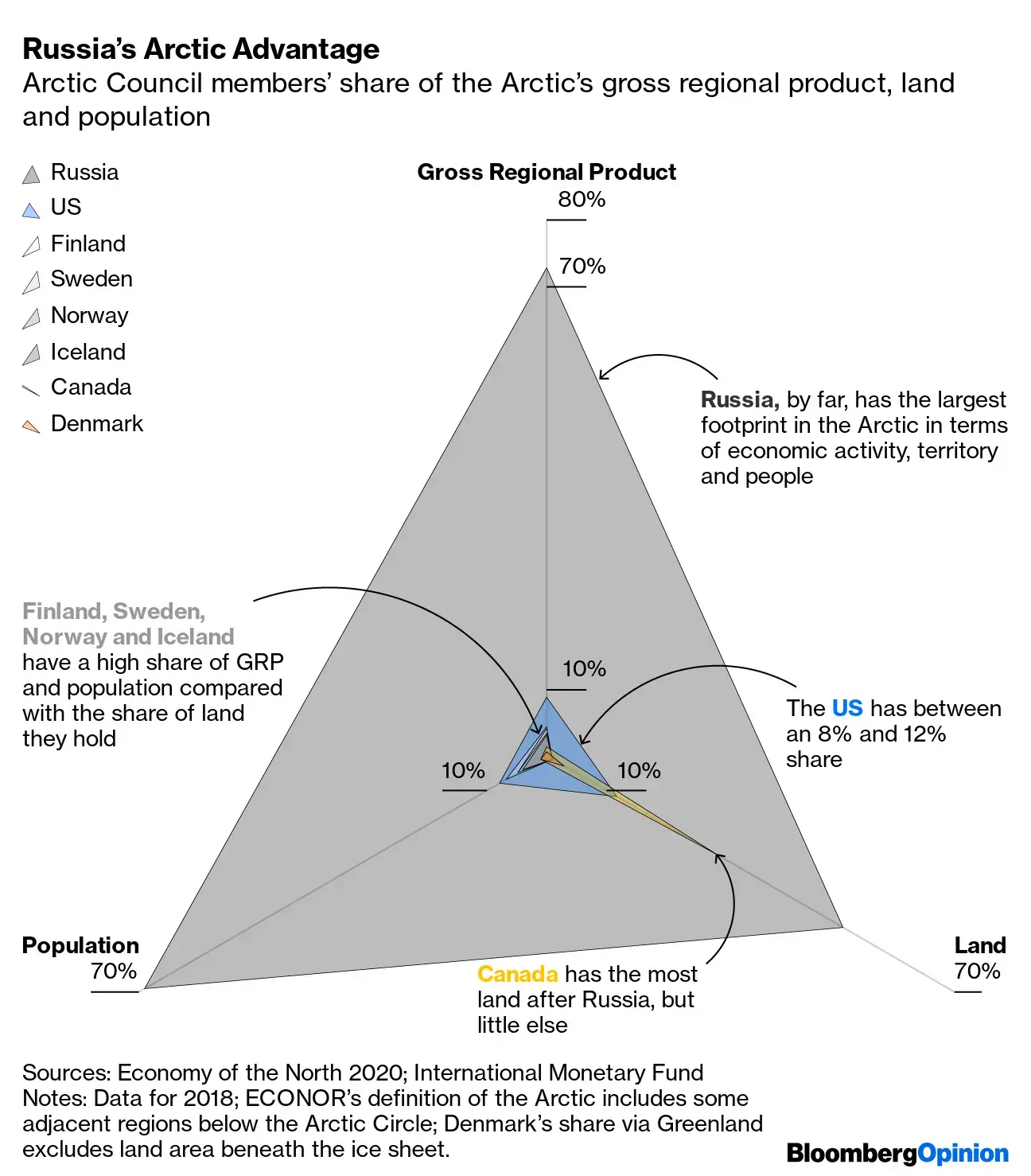
Russia’s strategic tilt back toward the Arctic under Putin coincided with Washington’s distraction from it. “With the last couple of decades, this place was really not focused. The forces of Alaska were not a division,” Major General Brian Eifler, who commands the 11th Airborne, tells me over the phone from his headquarters at Joint Base Elmendorf-Richardson. “They were a little bit of a hodgepodge of units gathered together, to support Iraq and Afghanistan deployments.” All told, the Army now has about 12,000 soldiers stationed in the state.
As Russia reclaims its Arctic presence, China has sought to stake out a new one. Like the polar explorers of yore, Beijing views an opening Arctic as an “undergoverned space,” as the Brookings Institution puts it, ripe for potential exploitation of resources, navigation routes and the assertion of great power status. The war in Ukraine has added another dimension, as China becomes the financier of, and primary market for, Russia’s Arctic energy production — shipped via the Bering Strait into the Pacific.
That is a chokepoint that forces in Alaska could potentially close, just one facet of the state’s indisputable identity as a strategic salient. Alaska is simultaneously the northernmost, westernmost and — with its island chain stretching just across the 180th meridian — easternmost state of the US. Ask yourself quickly: Which is closer to Kyiv, Washington or Anchorage? It’s the latter, by about 150 miles. “I think it’s sort of a gateway to the world, really,” says Eifler.
Mission: Expandable
When the High North, and its geopolitics, were more reliably frozen, the US was chiefly concerned with threats through, rather than to, the Arctic. The former haven’t gone away, especially as new menaces like hypersonic missiles appear. But the latter are now also coalescing and yet are less easily defined than a flight path.
Asked what a security event might look like, Eifler is straightforward in his lack of specifics: “I’m not sure what they’re necessarily always going to ask me to do. But I know I have to be able to operate and function in this environment.”




The Army warns that a sheer lack of people and infrastructure invites others to “create facts on the ground.” In this era of hybrid warfare, creating facts doesn’t necessarily mean battalions invading a frozen beach or landing field. Possibilities range from incursions by small, dispersed special forces to sabotage of communications networks to the surreptitious encroachment of foreign infrastructure and devices — drones, balloons and buoys, for example.
Absence of infrastructure breeds all the vulnerabilities of isolation. Roads largely peter out north and west of Anchorage and Fairbanks; more than four-fifths of communities, many of them Alaska Native, depend on aviation for year-round access. The power grid also ends, leaving many communities dependent on seasonal shipments of expensive fuel oil. The issue of food security weighs heavily. These are places on an emerging frontline way at the end of the supply line. Their risk of disruption is also on the Army’s checklist.
Alaska also sits on a seam between North America and the vast Indo-Pacific Command, multiplying the 11th Airborne’s deployable dimensions even further. (Eifler reports directly to General Charles Flynn, who commands US Army Pacific.)

When the strategic arena stretches to roughly a hemisphere, a focus on the tactical foundations seems wiser. Eifler comes back again and again to the unique environment. He wants the people under his command to “build up those Arctic callouses” — a matter of attitude and fortitude more than, as he puts it, “running around without your shirt when it’s 20 below zero, beating your chest.”
Echoing this thought is Sergeant Austin Ochoa, an “88 mike,” or Army truck driver, who hails from sweltering Texas border country and admits he used to get contact frostbite “just around my house” when first posted here. I attend his class on how to set up an H45 tent heater — a 60-pound contraption resembling an oversized wet/dry vac except full of burning jet fuel — which he somehow delivers like a human instruction manual with a sense of humor. Sitting some days later in a mess-hall booth, he explains what makes the Arctic different.
“With other training … you will have the majority of it being combat training: holding a rifle, looking down the barrel of a gun.” He goes on: “But with this training, it is about the basics, because as soon as the elements hit, it is genuinely like: ‘Hey, how do I take care of my people; how do I make sure that they eat; how do I make sure that they’re coping; how do I make sure that they’re drinking enough water?’”
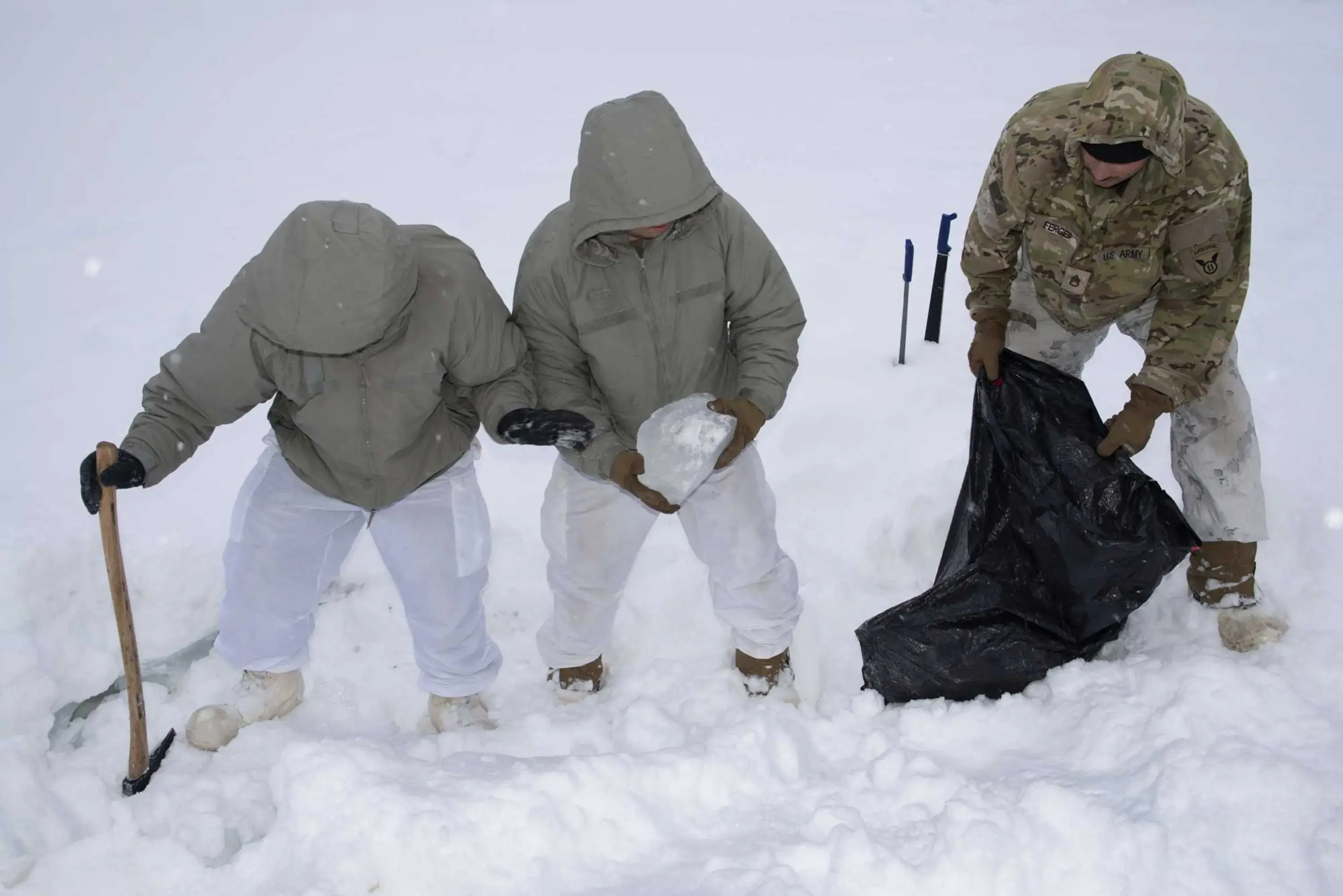
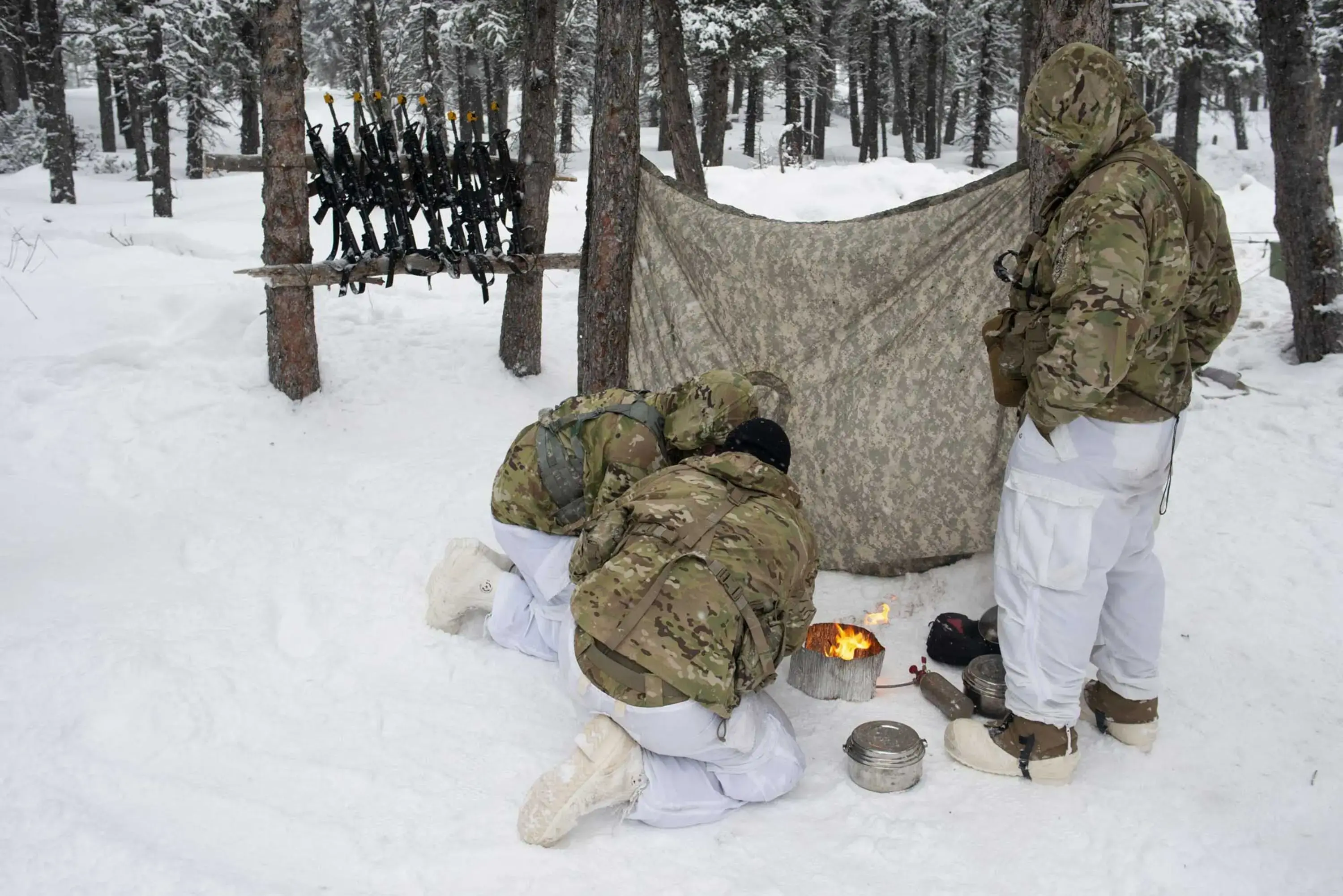
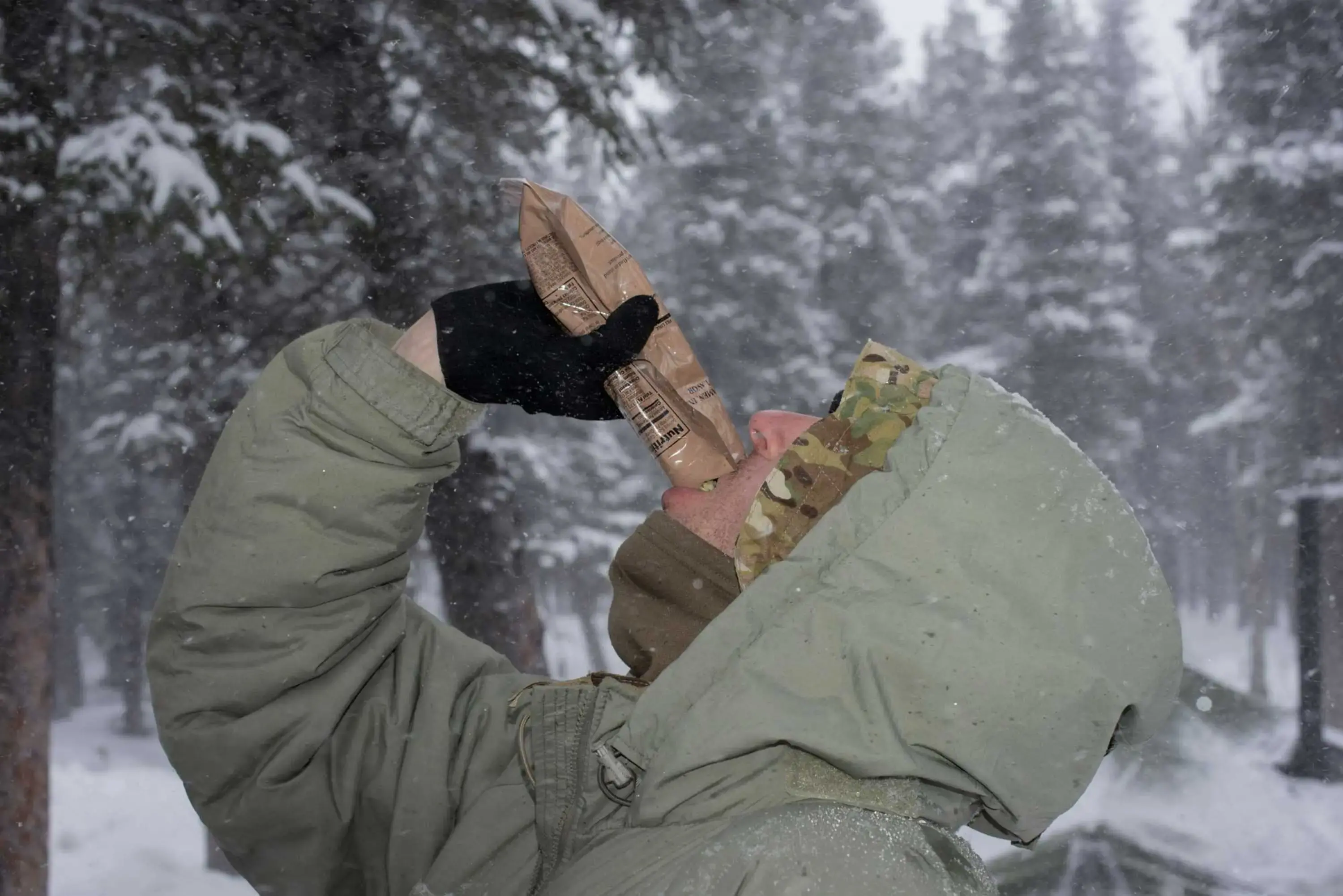
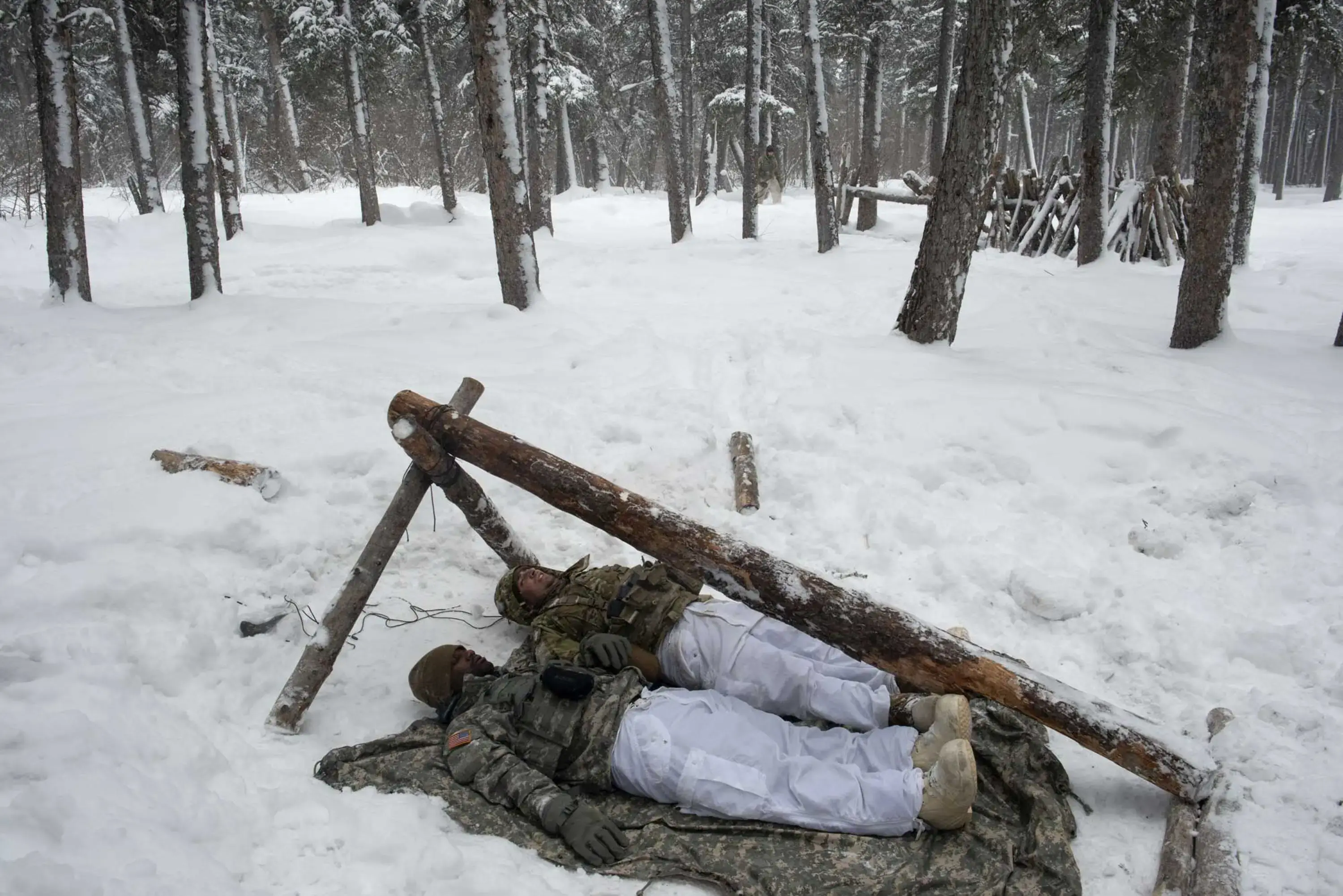
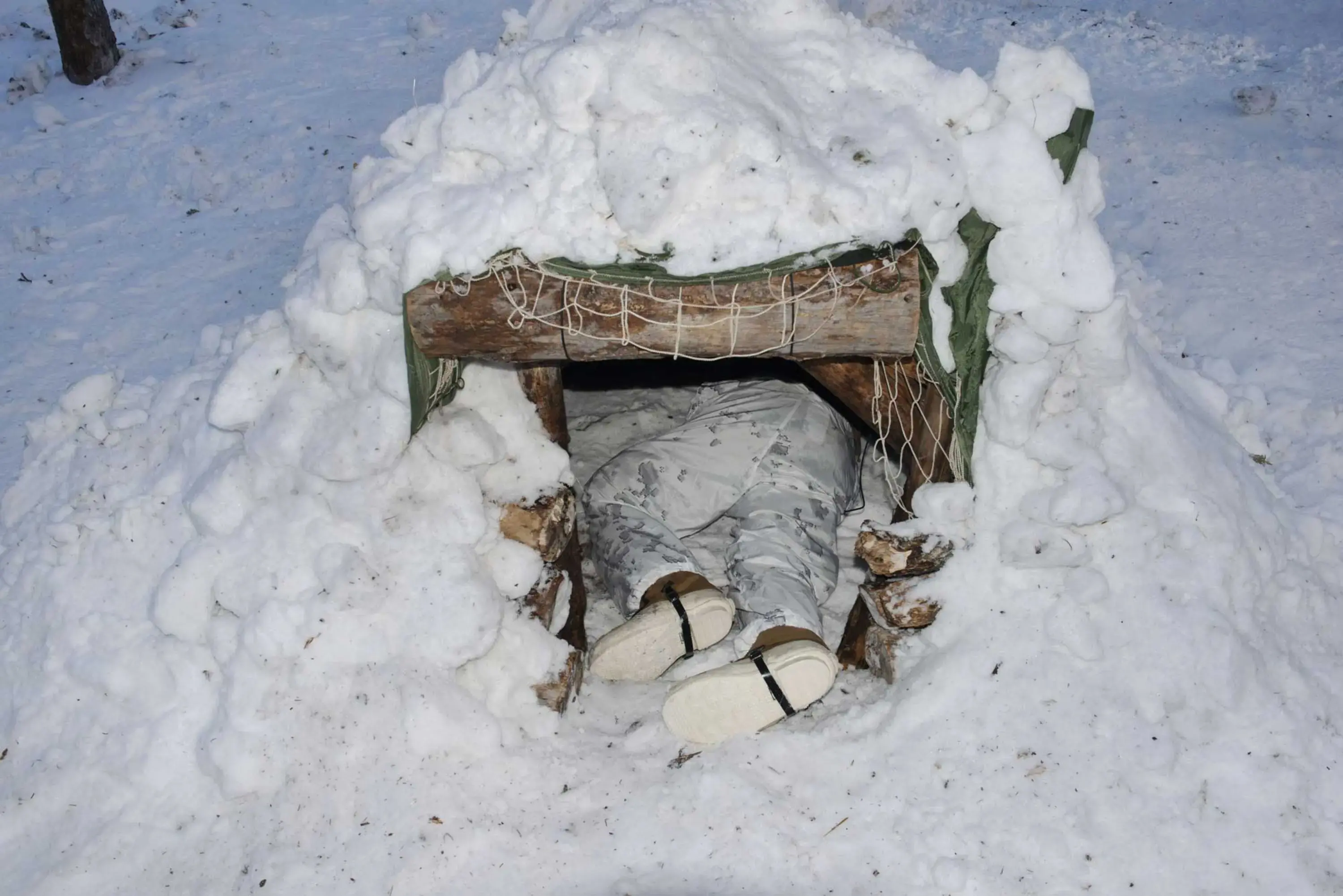
Forging the Arctic Warrior
Troy Bouffard, a retired Army master sergeant who now directs the Center for Arctic Security at the University of Alaska Fairbanks, sets all this in a wider context. “Today’s formula for what is an advanced military and what leads to success is: Being the best at precision-enabled, combined-arms warfare.” In short, being a credible force in the Arctic means, at the very least, operating there at the same proficiency expected anywhere else. On that front, “the Army is starting from scratch,” Bouffard says. “They’re testing socks on up.”
He’s right about the socks: Many instructors were trying out a new multi-layer clothing system, while the students mostly still wore a hodgepodge of older camo. Equipment-wise, the Army didn’t even have snow tires for Humvees until last year. The decades-old tracked vehicles called SUSVs that we bounced around in are due to be replaced soon with a modern model designed for the Arctic.
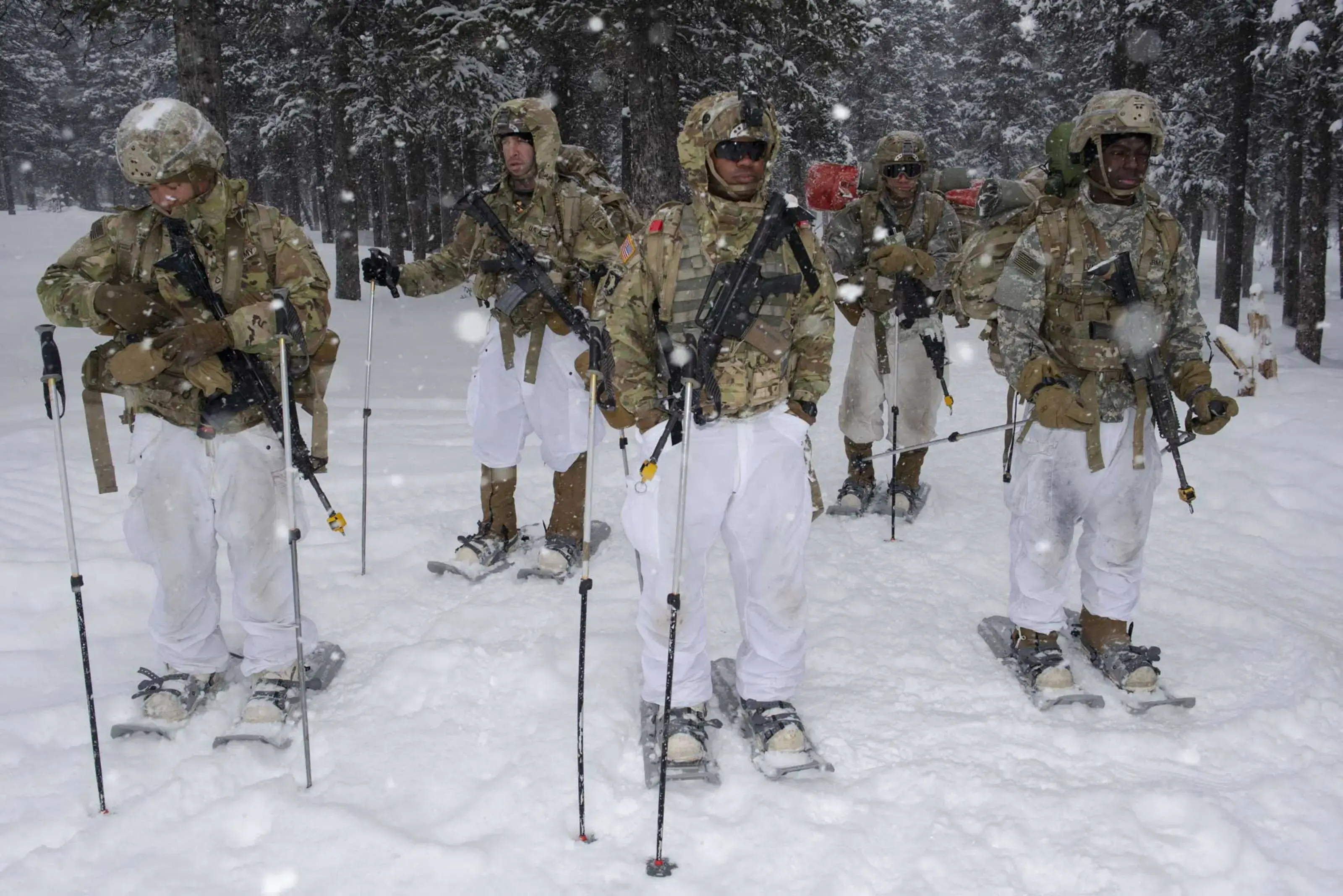
The biggest challenge, to borrow the title of a joint essay by Eifler and Bouffard, is “forging the Arctic warrior.” The extreme climate, isolation and long, dark winters impose mental as well as physical challenges, not just on soldiers but also the families that may follow them.
That said, the soldiers we meet display ample resilience and surprisingly good spirits. Exhausted, if young and fit, they hack away at frozen ground to make holes they’ll have to sleep in that night. There’s a strong sense of shared responsibility and even room for a kind of gallows humor. As one platoon prepares to snowshoe through a gathering blizzard, photographer Louie Palu, no stranger to military deployments, dryly observes, “Living the dream.” To which one soldier moving past on his poles responds: “Nightmares are dreams, too.”
But a long trail lies ahead. We spend our last day at the center crunching through snow following about two dozen soldiers taking ski lessons. When an instructor asks how many had ever worn skis before, fewer than half put up a hand. It is a surreal scene, heightened by the grandeur of the mountains, the brilliant blue sky and the cold. Newbies in camo and helmets wobble like foals down the gentle slope, many wiping out to calls of “Man down!” One cracks a beginner’s smile beneath his goggles as he stays upright all the way to the bottom. Small victories. At the foot of this particular bunny slope sit more-or-less neat rows of packs and assault rifles.
When I asked the veteran Decker how long it would take to retrain the Army’s Arctic muscles, he shook his head: “That I don’t know.” He adds, “It’s one of the things I wonder: Will we get to be a true master-of-the-Arctic division?” Developing those callouses, to use Eifler’s phrase, requires extended immersion in the Arctic’s niche environment, while standard Army practice is to keep soldiers circulating. “They like to keep the soup stirred,” as Decker puts it.

Here Be Dragons
Rather than necessarily regaining a “dominance" it never really had — the Cold War Arctic was always quietly contested — the Army must instead reaffirm its presence there. Besides the external environment, the US confronts its own propensity to blow hot and cold on the region. To most Americans, Alaska remains an exotic territory of the mind, associated variously with motifs like polar bears, oil, ice. The Army was in the vanguard of the state’s absorption; it ran the Department of Alaska for the first 10 years after its purchase in 1867 from Russia. It must now also lead in reestablishing the state’s strategic importance if it is to build a credible deterrent. The recent establishment of a Department of Defense Regional Center — essentially a think tank, and the first such one in over two decades — outside Anchorage was an important step. The next one should be a commitment to longer deployments. In a sense, the Army must replant its flag in already-sovereign US territory.
Planting flags, even metaphorical ones on your own land, can nonetheless be a provocative act in this part of the world. After all, Russia’s literal planting of a flag on the polar seabed and subsequent reopening of Arctic bases on its own soil is part of the justification for the US pivot northward. This is the geopolitical feedback loop that can spur narratives of potential conflict writing themselves like some manic AI.
Thankfully, national borders in the Arctic are mostly well-defined. The biggest ongoing dispute, concerning claims to the seabed, has thus far played out under the auspices of the United Nations’ Commission on the Limits of the Continental Shelf. For all the talk of a scramble for resources, echoing the jingoism of 19th-century empires, the word “scramble” doesn’t really fit a place seemingly constructed of only obstacles.
If anything, though, this makes the Army’s presence here more vital. Speak to any military expert about the Arctic, and the phrase “domain awareness” crops up quickly. Think of that as erasing all those “UNSURVEYEDs.” Blank space has been birthing dragons on maps for centuries. And while Alaska’s Cold War legacy makes it no stranger to sophisticated surveillance technology, boots on the ground come with lots of eyes attached, too. A fully acclimated 11th Airborne should deter any foreign adventurousness while also easing Washington’s more paranoid tendencies.

The Arctic’s brief age of innocence is reverting to something more fraught. Just as the carbon emissions now warming the region didn’t originate there but do their insidious work regardless, preventing the wider world’s tensions from crossing 66.5 degrees north is highly improbable. When Russia launched its opening fusillade against Ukraine, for instance, the other Arctic Council members swiftly, and correctly, suspended their cooperation.
Russia’s long-standing Arctic ambitions are justifiable on their own geographic merits. But they cannot be isolated from Moscow’s wider anti-Western posture — realized, they would support Putin’s aggression elsewhere. Meanwhile, China’s designation by Washington as the country’s “pacing threat,” as well as growing alignment between Moscow and Beijing, makes the notion of any Chinese involvement in the Arctic inherently fraught for the US today.
The week before our visit to their turf, members of the 11th Airborne flew across the pole to train alongside a force that wrote the book on winter warfare, the Finns. “They were born in the snow and it’s just the way they roll,” Decker admires.
Yet Finland’s abrupt turn from nonaligned to formal NATO ally captures the Arctic’s transformation into an extension of our other theaters of confrontation. Finland was compelled by a conflict raging far from the High North to prepare for the possibility of it spreading that way nonetheless. The same heightened, if still inchoate, sense of alert informs the methodical hardships of Black Rapids. There, in a landscape imperiously indifferent to humanity’s squabbles, the wider world’s rivalries are suddenly naked to the eye.

Graphics and production by Elaine He.
With assistance from Demetrios Pogkas and Hayley Warren.











